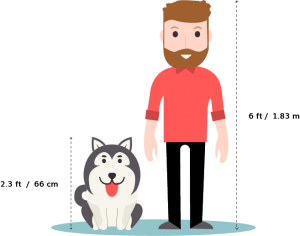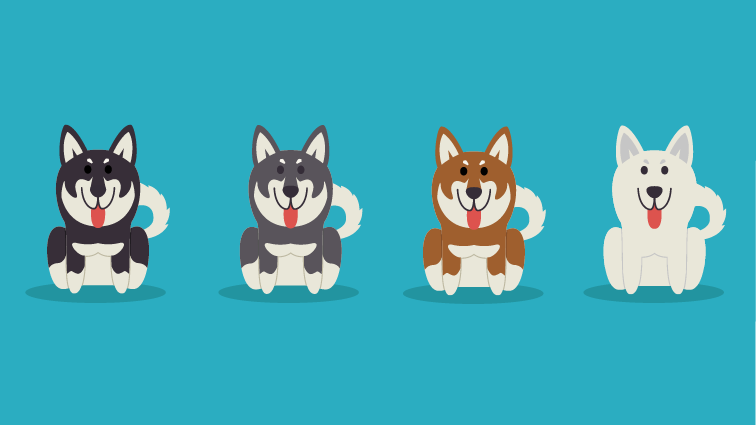Alaskan Malamute Vs Siberian Husky – What’s The Difference?
The Alaskan Malamute and Siberian Husky are both strong dogs bred to sustain the extreme cold. Their wolfish appearances may look intimidating but in reality, their personalities are anything but. These two loveable, friendly and intelligent dog breeds are adored the world over—read on to learn how to tell the malamute from the husky.
Mục Lục
Malamute vs husky history
The Siberian Husky is one of the oldest dog breeds on the planet. They were first bred by the Chukchi, an ancient nomadic Siberian tribe, in the northeastern regions of what’s now Russia. The Chukchi used huskies as sled dogs for transportation, but they were also regarded as family members and slept with the children in the tribe to keep them warm. Siberian huskies were exported to Alaska in 1908 and were used as a sled dog during the gold rush. The breed has changed only slightly from the original huskies from the Chukchi tribes.
The Alaskan malamute is also an ancient breed and one of the oldest Arctic sled dogs. The breed was brought to Alaska thousands of years ago by native people crossed the land bridge from Siberia into the region. A tribe called the Mahlemuts, in the northeastern area of the Seward Peninsula developed the Alaskan malamute. The dogs were used for hunting, chasing away polar bears, and transporting food and camp supplies. Like huskies, malamutes were a valued member of their tribe and treated like family. Most Malamutes today can trace their heritage to the ‘Kotzebue’ strain from the Norton Sound area of Alaska.
Malamute vs husky temperament
Siberian huskies are medium sized working dogs and they’re known for their intelligence and independence. They’re still very affectionate but not particularly needy. Although their intelligence and ability to learn is remarkable, huskies are notoriously difficult to train and can get bored easily so they are best with confident, experienced dog owners.
Huskies are sociable and full of energy. Due to their high intelligence, they can become bored if they’re not given enough mental stimulation or exercise. They love to dig and can cause havoc with flower beds, gardens and even some parts of the home if left unsupervised. They also have a reputation for being escape artists—they love to wander off an have an adventure on their own.
Alaskan malamutes are playful, loveable dogs with outgoing dispositions. Like huskies, they are friendly with everyone, including strangers. Like huskies, they’re also pack animals so they like to be included in all the family activities. They’re equally as mischievous as huskies and also enjoy digging holes, or even raiding the bins, so it’s important to keep them entertained. Malamutes can be cheeky but good training will bring out their intelligence. Like huskies, they can be quite challenging to train so they also require an experienced dog owner who has the confidence to set boundaries via positive reinforcement and lead.
Both these highly intelligent dogs need a lot of physical exercise and mental stimulation. If they’re left alone for long periods of time they can become bored or frustrated so if you’d prefer not to leave your dog alone Rover.com has lots of wonderful sitters who offer dog boarding across the country!
Huskies and malamutes don’t tend to make good watch dogs, they might share the looks of their wolf ancestors, but both dog breeds are very friendly, even with strangers. Neither huskies or malamutes tend to be big barkers either, so they may not be a very effective home alarm system! Instead, they can howl and they do, at the moon or whenever it suits them!
Both breeds will benefit from obedience training, particularly from puppyhood.
Malamute vs husky with families
Huskies make great family pets and are good with children. They are also good in a multi-dog households. If raised with other animals as a puppy, huskies can live in a multi-pet household, too. We’ve compiled a husky puppy fact-file to help you decide whether a Husky pup is the dog for you. Originally, huskies had a strong prey drive towards smaller animals like squirrels, rabbits and cats, but if raised with small animals, they can enjoy the company of pets of all sizes.
Malamutes also make great family pets and are good with children. Their large size and high energy means that they can overpower small children though, so they’re best for households with kids over the age of 5. They’ll also thrive in multi-dog and multi-pet households as long as they’ve been raised with other small animals as a puppy.
Malamute vs husky size and appearance
Although huskies and malamutes both have wolf-like features, Malamutes are taller and heavier than huskies. Husky males are approximately 53-60 cm tall, whilst a female is about 50-56 cm tall. Male malamutes are approximately 64 cm tall and females are 58 cm tall. Husky males weight 20-27 kg and females weight 16-22 kg. By contrast, Malamutes can vary greatly in weight. The majority weigh between 34-38 kg but some can be over 45 kg.




Huskies come in a variety of colours. It can also appear that they are wearing a white mask with the different shade of fur around their face.

 Malamutes range from light grey to black or sable to red whist their underbelly, feet and parts of their leg are predominately white. Their face will also have white markings usually around the forehead and neck.
Malamutes range from light grey to black or sable to red whist their underbelly, feet and parts of their leg are predominately white. Their face will also have white markings usually around the forehead and neck.


Both dogs have very thick fur, bushy tails, and erect ears. Huskies are faster than malamutes but the malamute’s larger build means they are the stronger of the two dogs.




Both huskies and malamutes can have brown or blue eyes, one eye that’s blue or particoloured eyes. A Husky’s ears are medium and triangular in shape and sit high on their head. A Malamute’s ears are similar in shape but they sit farther apart on the head.
A Husky has a muzzle that is medium in length and width and tapers slightly towards the nose. Their noses can be black or pink which is called a snow nose. A malamute’s muzzle is more bulky and is the same width from the face to the tip of the nose. A malamute’s nose is usually black although they can have a pink snow nose too.




Both huskies and malamutes have a bushy tails. Malamutes also have a corkscrew tail that they’ll use to keep their faces warm.
Malamute vs husky grooming and shedding
Both dogs are designed to handle the extreme cold and have a lot of fur. A husky has a double coat with medium length hair. Their top coat is straight and their undercoat is soft and dense. Their thick coat that keeps them warm in the winter will also shed (a lot) in the spring and autumn. But, they tend to shed less in cooler climates. That said, huskies are fairly clean breeds and tend to clean themselves. They don’t omit much of an odour or need too much grooming either, just a lot of brushing, especially in shedding seasons. Brush them at least once a week during the year and daily when they are shedding.
Malamutes also have a dense double coat. Their top coat is thick and coarse and known as the guard coat. Their undercoat is one or two inches thick, is oily and woolly and designed to keep them warm and repel wetness. A Malamute’s coat is longer around the shoulders, neck, and back. Plus, their long hair over their thighs can sometimes resemble trousers. Malamutes shed twice yearly and their hair can fall out in clumps. Like a husky, they’re fairly odour-free and rarely need baths, unless they roll in something stinky. They also clean themselves like huskies. Brush them at least once a week during the year and daily when they are shedding.
Malamute vs husky exercise
As both dogs are pack animals, they’ll love participating in family activities and playing. Huskies are high energy dogs, and they’ll stay happy with a lot of intense exercise, about 30-60 minutes each day. They would make a great companion for hikes, long walks, runs or just joining you on your own activities. Malamutes also need a lot of exercise to keep them happy and prevent boredom. As working dog breeds, they enjoy doing tasks but will also love to run, play or go on hikes.
Be cautious in the summer months—that thick coat means that both dogs can easily overheat in hot weather.
Malamute vs husky health
Huskies and malamutes have a life expectancy of 12-15 years. Both breeds are healthy but can suffer from some health conditions. Huskies can develop eye problems like cataracts, corneal dystrophy, and progressive retinal atrophy. Malamutes can also suffer from cataracts, are prone to hip dysplasia and hypothyroidism.






